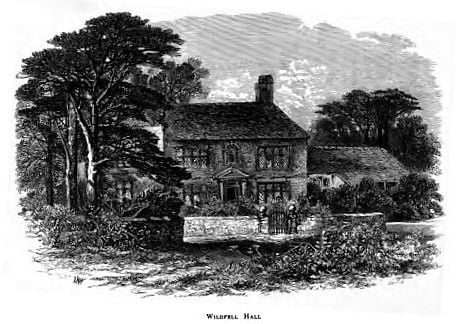The House That May Have Inspired ‘Wuthering Heights’ Is Up for Sale
A chamber in Ponden Hall bears similarity to the room where the narrator Lockwood passes a fitful night of sleep—and dreams of an ‘ice-cold’ ghost
/https://tf-cmsv2-smithsonianmag-media.s3.amazonaws.com/filer/85/e0/85e0a2d9-45c9-46eb-94a1-139dd1f041c9/gettyimages-606243066.jpg)
In September 1824, six-year-old Emily and four-year-old Anne Brontë were walking across the moors of Yorkshire, accompanied by their brother, Branwell, and a servant, when an ominous storm began to rumble. The group ran toward a grand estate called Ponden Hall, reaching the house just as a tremendous mudslide rushed across the moor, brought on by days of rain.
This narrow escape marked the Brontës’ first visit to Ponden, but the family would continue to frequent the home—under happier circumstances—in the years to come. Ponden is, in fact, believed to have inspired the writing of both Emily and Anne. Now, a Brontë sisters fan with £1.25 million (around $1.6 million) to spare can claim this historic property as their own; as Sharon Dale reports for the Yorkshire Post, Ponden Hall has been put up for sale.
The home’s current owners, Julie Akhurst and Steve Brown, purchased Ponden in 1998 and have been running it as a bed and breakfast that caters to both Brontë enthusiasts and those simply seeking a quiet stay in the English countryside. But Akhurst and Brown now plan to retire and are looking to downsize, prompting them to put the house on the market. According to Fine & Country, the agency that is listing the property, Ponden Hall “offers versatile accommodation, with up to ten bedrooms, ideal for its current running as a bed and breakfast ... but which could also easily be a superb family home.”
Parts of Ponden Hall date back to the 1500s, but the main house was built in 1634. A “peat loft,” where the Brontës are believed to have taken shelter during that mudslide, was constructed in 1680. A major renovation in 1801 connected the loft to the main house and “saw the formation of a grand new entrance” and the construction of what was reportedly the “finest library” in the area, Fine & Country writes.
The Brontës became friends with the Heatons, the family that owned Ponden Hall, and often made use of this grand library, which once boasted a Shakespeare first folio. “It’s incredible to think Emily would have sat here reading,” Akhurst tells Dale. “We have a catalogue of the books that were here then and they probably influenced her. There were gothic novels and books on necromancy and dark magic.”
The house itself also seems to have left an impression on the sisters’ imagination. “There can be little doubt that Ponden Hall was the architectural inspiration for Anne Brontë’s Wildfell Hall,” writes Brontë expert Nick Holland. “ It shares the same central portico underneath a date bearing plaque, and flanked by tall latticed windows.”

Possible references to the house can also be detected in Emily’s masterpiece Wuthering Heights. The story begins in 1801—the same year as the major renovations at Ponden Hall, which were commemorated with a plaque above the main entrance.Ponden is often associated with Thrushcross Grange, the home occupied by the Linton family in the novel. “[T]he long, tree-lined drive which then existed, the large upstairs room with a window either end correspond with that house,” explains Ponden Hall’s website. But in “size, style and detail,” Ponden may bear more similarity to Wuthering Heights, the titular farmhouse occupied by the brooding Heathcliff.
In the early chapters of the book, the narrator Lockwood sleeps at Wuthering Heights in a chamber with a bed contained in a “large oak case, with squares cut out near the top, resembling coach windows.”
“[O]ld documents relating to the house describe a box bed in a room across from the library and you can see where it was bolted to the wall by the window,” Akhurst tells Dale. “It is just how it is described in Wuthering Heights.” Akhurst and Brown have, in fact, installed a replica of the “box bed,” which visitors can sleep in today.
Next to the bed is a small window that may have inspired one of Wuthering Heights’ more haunting scenes. During a fitful night of sleep, Lockwood dreams that he hears a tree knocking against the window in his room. But when he reaches out to grasp the “importunate branch,” his “fingers closed on the fingers of a litte, ice-cold hand!”
“The intense horror of the nightmare came over me,” Lockwood recounts. “I tired to draw back my arm, but the hand clung to it, and a most melancholy voiced sobbed, ‘Let me in—let me in!’”
When Akhurst and Brown purchased Ponden Hall, it was badly in need of upkeep, and the duo have spent the past 20 years carefully renovating it. They allowed “Brontë pilgrims” to explore the house for free, reports Atlas Obscura’s Evan Nicole Brown, and offered “cream teas and tours” to locals who didn’t need to stay at the property overnight. Akhurst tells Dale that once she sells the house, she plans to spend her retirement researching and writing a history of Ponden Hall—“a fitting tribute to a home that we have loved so much.”